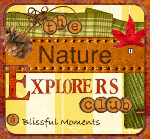
Welcome to The Nature Explorers Club. I am a mom who loves nature and loves to share it with others. Using my experience as an Outdoor Education Instructor and the basic guidelines of the book "Nature For the Very Young", I will be venturing out to explore the great outdoors every week with my kids. Every week I will share what we did, and every week you are welcome to join us. I will post the topic of the week, then one week later I will share what we did and give you a chance to share as well. So get your boots ready, because we're going exploring!
This weeks topic is:

Flower to Seed
As we transition from Summer to Fall, this is the perfect time to learn about the purpose of flowers, since you can typically find one in all of its different stages in one single plant. The main purpose of a flower is to produce more of that same flower, this is called reproduction.
Search around for some flowers. Take a close look at them and see if you can find the major parts to the flower, the stem, leaf, petal, stamen, and pistil. If you can, pull a flower apart to take a closer look at each part.
The colorful petals attract insects like bees who are looking for pollen. Smell the petals. Is there a different smell? This also helps attract insects.
The pollen is located on the stamen. Try brushing a stamen on your finger. Does it leave a mark of pollen? While the bees are in the flower collecting pollen (to later make into honey), parts of pollen from other flowers will stick to the pistil. For a flower to make seeds, it needs pollen from another flower.
At the base of the pistil, is the ovary. This is where the seeds will be made. Allow the child to break open an ovary and explore.

Now try to find a flower that has finished blooming and is in the process of making seeds. Again open the ovary and look inside. Does it look any different?

Finally, see if you can find a flower that has completed the process of making seeds. It will most likely be brown, hard and dead. Break it open and look for the seeds. These seeds will eventually fall to the ground and nest spring could sprout into new plants.

Don't be concerned with going too deep with terminology, or explaining the entire process. The purpose of this activity is to take something familiar and explore it further with the hope of stirring a desire to explore and learn more. If your child asks questions, then seek the answers. If they are content to sniff the pretty flowers, then enjoy the sweet smells.
Activities
* try to collect flowers to represent every color of the rainbow.
* collect as many different flowers as possible then make a simple graph showing how many of each color you have
*create your own flower parts out of felt, cardboard, or laminated paper and let your child try to piece the "puzzle" together to form a whole flower.
*collect as many seeds as you can and create a collage using contact paper or a piece of paper thinly coated with glue
* play "pin the pistil on the flower" using large flower parts.
*read the book "The Reason for a Flower" by Ruth Heller
*you can role play, a flower growing, a flower dropping its seeds, or a bee visiting a flower.
Check back in one week to see what we did, and to share what you did as well.


Wonderful ideas! I hope to link up this week!
ReplyDeleteYahoo! I love this! Your blogging will help me get outside with the kiddos, enjoy nature, and accomplish science. Thanks!
ReplyDeleteGranola Mom
So neat. I am going to try to do this!Thanks!
ReplyDeleteThis looks great! I'm hoping to join you. ;-)
ReplyDelete